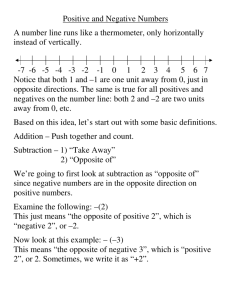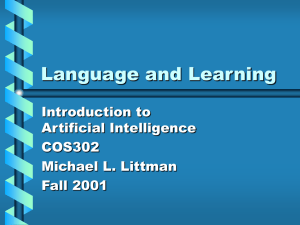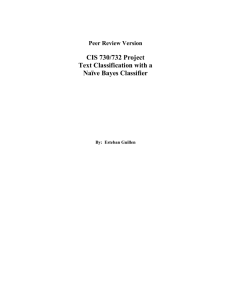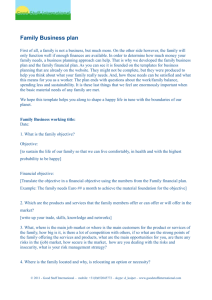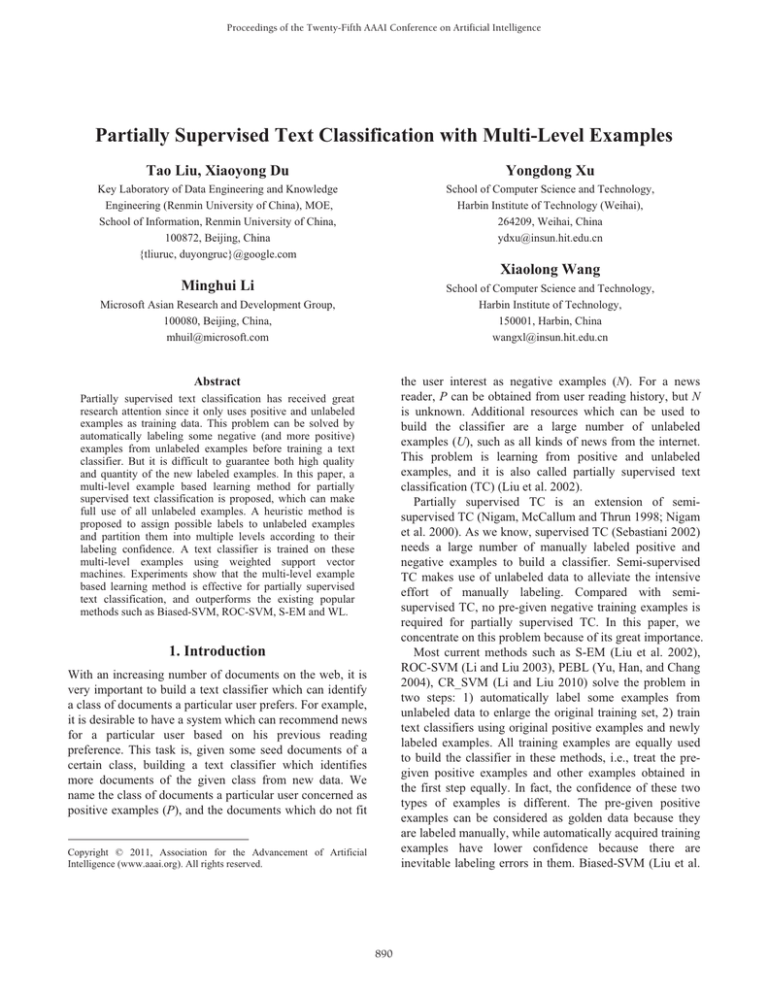
Proceedings of the Twenty-Fifth AAAI Conference on Artificial Intelligence
Partially Supervised Text Classification with Multi-Level Examples
Tao Liu, Xiaoyong Du
Yongdong Xu
Key Laboratory of Data Engineering and Knowledge
Engineering (Renmin University of China), MOE,
School of Information, Renmin University of China,
100872, Beijing, China
{tliuruc, duyongruc}@google.com
School of Computer Science and Technology,
Harbin Institute of Technology (Weihai),
264209, Weihai, China
ydxu@insun.hit.edu.cn
Xiaolong Wang
Minghui Li
School of Computer Science and Technology,
Harbin Institute of Technology,
150001, Harbin, China
wangxl@insun.hit.edu.cn
Microsoft Asian Research and Development Group,
100080, Beijing, China,
mhuil@microsoft.com
the user interest as negative examples (N). For a news
reader, P can be obtained from user reading history, but N
is unknown. Additional resources which can be used to
build the classifier are a large number of unlabeled
examples (U), such as all kinds of news from the internet.
This problem is learning from positive and unlabeled
examples, and it is also called partially supervised text
classification (TC) (Liu et al. 2002).
Partially supervised TC is an extension of semisupervised TC (Nigam, McCallum and Thrun 1998; Nigam
et al. 2000). As we know, supervised TC (Sebastiani 2002)
needs a large number of manually labeled positive and
negative examples to build a classifier. Semi-supervised
TC makes use of unlabeled data to alleviate the intensive
effort of manually labeling. Compared with semisupervised TC, no pre-given negative training examples is
required for partially supervised TC. In this paper, we
concentrate on this problem because of its great importance.
Most current methods such as S-EM (Liu et al. 2002),
ROC-SVM (Li and Liu 2003), PEBL (Yu, Han, and Chang
2004), CR_SVM (Li and Liu 2010) solve the problem in
two steps: 1) automatically label some examples from
unlabeled data to enlarge the original training set, 2) train
text classifiers using original positive examples and newly
labeled examples. All training examples are equally used
to build the classifier in these methods, i.e., treat the pregiven positive examples and other examples obtained in
the first step equally. In fact, the confidence of these two
types of examples is different. The pre-given positive
examples can be considered as golden data because they
are labeled manually, while automatically acquired training
examples have lower confidence because there are
inevitable labeling errors in them. Biased-SVM (Liu et al.
Abstract
Partially supervised text classification has received great
research attention since it only uses positive and unlabeled
examples as training data. This problem can be solved by
automatically labeling some negative (and more positive)
examples from unlabeled examples before training a text
classifier. But it is difficult to guarantee both high quality
and quantity of the new labeled examples. In this paper, a
multi-level example based learning method for partially
supervised text classification is proposed, which can make
full use of all unlabeled examples. A heuristic method is
proposed to assign possible labels to unlabeled examples
and partition them into multiple levels according to their
labeling confidence. A text classifier is trained on these
multi-level examples using weighted support vector
machines. Experiments show that the multi-level example
based learning method is effective for partially supervised
text classification, and outperforms the existing popular
methods such as Biased-SVM, ROC-SVM, S-EM and WL.
1. Introduction
With an increasing number of documents on the web, it is
very important to build a text classifier which can identify
a class of documents a particular user prefers. For example,
it is desirable to have a system which can recommend news
for a particular user based on his previous reading
preference. This task is, given some seed documents of a
certain class, building a text classifier which identifies
more documents of the given class from new data. We
name the class of documents a particular user concerned as
positive examples (P), and the documents which do not fit
Copyright © 2011, Association for the Advancement of Artificial
Intelligence (www.aaai.org). All rights reserved.
890
2003) solves the problem by minimizing the number of
unlabeled examples classified as positives and constraining
golden positive examples to be correctly classified. BiasedSVM is a one-step method, which does not select
additional training examples. Its performance is not very
good when the given positive example set is small.
A novel multi-level example based learning method is
therefore proposed in this paper for partially supervised
TC. A heuristic method is firstly used to generate multilevel examples according to their confidence. Both the
quality and quantity of training examples are important for
the training of a high quality classifier. It is difficult to
guarantee both high precision and recall for labeling new
training examples, so our multi-level example generation
method needs a trade-off between precision and recall by
partitioning training examples according to their
confidence into multiple levels. Secondly weighted support
vector machine is used to discriminatingly treat multi-level
training examples. Experimental results indicate that the
proposed method outperforms traditional methods.
Before probable positives and negatives are selected
from U, some feature words which can differentiate
positive and negative examples are identified (Blum and
Langley 1997). Since there are no pre-given N, beside P
and U, it is better to identify positive feature words which
can reflect and represent the characteristic of P. Positive
Degree (PD) is used to judge if an unlabeled document is a
positive example. The document positive degree (PDdoc) is
defined using the positive feature set in section 2.1.
2.1 Positive Feature Selection
Positive features are words which can reflect and represent
the characteristics of positive examples and distinguish it
from that of negative examples. Two statistical criteria
named Specialty and Popularity are used to judge whether
a word is a positive feature or not. These two criteria make
use of the statistical information of words among P and U
to identify positive features.
The Specialty criterion depicts a positive feature
specially used in P. As for word occurrence frequency, a
word tends to be a positive feature if it occurs more
frequently in P than in U. For word w, its Specialty is as:
2. Method
ܵݕݐ݈ܽ݅ܿ݁ሺݓሻ ൌ ݂ሺݓǡ ܲሻȀሺ݂ሺݓǡ ܲሻ ݂ሺݓǡ ܷሻሻ
The purpose of partially supervised TC (Liu et al. 2002) is
to find function f which maps X to Y, where X is documents
set, and Y is labels set which is {-1, +1}. The training
examples include a small number of positive examples (P),
and a large number of unlabeled examples (U). Unlabeled
examples are mixed with other positive examples and
negative examples (N). The assumption is: examples in P
are randomly selected from all positive examples. i.e. the
feature distribution of positive examples in P is the same as
that of positive examples in U.
A multi-level example based learning (MLEL) method
is proposed for partially supervised TC. A heuristic method
is firstly used to label additional training examples from U.
Multi-level training examples are generated including
golden positives (GP), potential positives (PP), strong
negatives (SN), reliable negatives (RN) and potential
negatives (PN). A learning method based on weighted
support vector machine (WSVM) is used to train the text
classifier on these multi-level examples. Algorithm 1
shows the general framework of the MLEL method.
Algorithm 1: MLEL (P, U)
Input: positive documents P, unlabeled documents U
Output: a text classifier
Obtain positive feature set (PF) and word positive
degree (PDword) for each feature using Positive Feature
Selection algorithm.
Use Multi-level Example Generation algorithm to
obtain GP, PP, SN, RN and PN.
Train text classifier using WSVM.
(1)
where f(w, P) and f(w, U) denote the frequency of word w
occurring in P and U respectively.
The Popularity criterion depicts a positive feature
popularly used in P. Supposing two words have the same
occurrence frequency in P, the one which occurs in more
positive examples is more likely a positive feature than
another. The potential hypothesis is that the word with
more uniform occurrence distribution in a certain domain
is more likely to be a feature of this domain (Navigli and
Velardi 2004). Information entropy is used to measure the
distribution of word w in P as shown below:
ು
ݐ݊ܧሺݓǡ ܲሻ ൌ െ σୀଵ
ܾܰܲݎሺ݀ ȁݓሻሺܾܰܲݎሺ݀ ȁݓሻሻ (2)
where NProb(di|w) denotes the normalized probability of
word w occurring in document di, and nP denotes the
number of documents of P. By normalizing the above
entropy into range [0, 1], popularity of word w can be
expressed as:
ܲݕݐ݅ݎ݈ܽݑሺݓሻ ൌ ݐ݊ܧሺݓǡ ܲሻȀܼ
(3)
where Z is the normalization factor, which is the maximal
value of Ent(w,P), i.e. log(np).
Normalized probability NProb(di|w) is used to take into
account the influence of different document lengths on the
word occurrence probability, and expressed as:
ܾܰܲݎሺ݀ ȁݓሻ ൌ
ሺௗ ȁ௪ሻȀ
ು ሺሺௗ ȁ௪ሻȀ ሻ
σೕసభ
ೕ
ೕ
(4)
where ܾܲݎሺ݀ ȁݓሻ ൌ ݂ሺݓǡ ݀ ሻȀ݂ሺݓǡ ܲሻ,݈ ൌ σ௪אௗ ݂ሺݓǡ ݀ ሻ.
891
ܲܦௗ ሺ݀௫ ሻ തതതതതതതതത
ܲܦሺܲሻ
PDword is defined on the basis of Specialty and
Popularity as:
ܲܦ௪ௗ ሺݓሻ ൌ ܵݕݐ݈ܽ݅ܿ݁ሺݓሻ ܲݕݐ݅ݎ݈ܽݑሺݓሻ
2.2.3 Multi-Level Negatives Acquisition
Document dx whose PDdoc(dx) equals zero is taken as a first
level negative example, i.e. those unlabeled examples
which do not contain any positive features are taken as
negative examples. Since it is normal for a negative
example to contain a small number of positive features,
this labeling criterion is rigorous and yields high confident
negatives called strong negatives (SN).
To select the second level negative examples with much
looser criterion than strong negatives acquisition, we use
average positive degree of all unlabeled documents as the
empirical threshold. Document dx is taken as a medium
confident negative example if it satisfies the formula (8).
This set of negatives is called reliable negatives (RN).
(5)
Both Specialty and Popularity are important for
selecting high quality positive features. We take word w as
a positive feature if it satisfies ܵݕݐ݈ܽ݅ܿ݁ሺݓሻ ߙ ,
ܵݕݐ݈ܽ݅ܿ݁ሺݓሻ ߚ and ܲܦ௪ௗ ሺݓሻ ߛ . ߙ , ߚ and ߛ are
thresholds for Popularity, Specialty and PDword
respectively. They are determined as the average values of
Popularity, Specialty and PDword according to the
experiments.
2.2 Multi-Level Example Generation
Both the quality and quantity of training examples are
important for the training of a high quality classifier, but it
is difficult to obtain both high precision and recall for
newly labeled training examples. Here, our method is used
to select as many new training examples as possible from
unlabeled examples to make the best use of them. Multilevel examples are generated based on document positive
degree which reflects the example labeling confidence.
Then, a text classifier is discriminatively trained using
these multi-level examples.
2.2.1 Document Positive Degree
For each unlabeled example, we use the document positive
degree (PDdoc) to describe its possibility of being a positive
example. The positive degree of document di is computed
based on the positive features selected using the following
formula:
ܲܦௗ ሺ݀ ሻ ൌ ሺσ௪אிǡ௪אௗ ܲܦ௪ௗ ሺݓሻሻȀሺ݈ ሻ
(7)
തതതതതതതതത
Ͳ ൏ ܲܦௗ ሺ݀௫ ሻ ܲܦሺܷሻ
(8)
Remaining unlabeled examples after selecting PP, SN
and RN are taken as the third level negative examples with
low confidence and called potential negatives. We discover
through experiments these remaining unlabeled examples
are also useful for training classifier.
2.3 Multi-Level Example Based Learning
Weighted Support Vector Machine (Vapnik 1995) is used
to train the classifier on multi-level examples, and assign
different weights to the examples with different
confidence. The optimizing goal is:
ଵ
ǣ ԡݓԡଶ ܿାᇱ σீא ߦ ܿାᇱᇱ σא ߦ
ଶ
ܿିᇱ σאௌே ߦ ܿିᇱᇱ σאோே ߦ ܿିᇱᇱᇱ σאே ߦ
(6)
(9)
ǣ ݕ ሺݔ ் ݓ ܾሻ ͳ െ ߦ ሺ݅ ൌ ͳǡʹǡ ǥ ǡ ݊ሻ
where log(li) is the normalization factor and ݈ ൌ
σ௪אௗ ݂ሺݓǡ ݀ ሻ . The positive degree of a document
increases with the possibility of the document as a positive
example.
2.2.2 Multi-Level Positives Acquisition
In the problem of partially supervised TC, the set of pregiven positive training examples with highest labeling
confidence is a first-level positive named as golden
positives (GP).
It can be seen from formula (6) that the possibility of an
unlabeled document to be a positive example is determined
by the number of positive features it contains and the
positive degree of all included positive features. PDdoc(di)
increases with the probability of di as a positive example.
ܲܦሺܷሻ denote the average
Supposing തതതതതതതതത
ܲܦሺܲሻ and തതതതതതതതത
document positive degree on examples of P and U
respectively. Document dx in U which satisfies the formula
(7) is taken as second-level positives, named as potential
positives (PP). It is very difficult to extract positive
examples from U, so we will not extract positive examples
besides potential positives.
where ߦ is
a slack variable which allows the
misclassification of some training examples, ܿାᇱ , ܿାᇱᇱ , ܿିᇱ , ܿିᇱᇱ
and ܿିᇱᇱᇱ represent the penalty factors of misclassification
for GP, PP, SN, RN and PN example sets respectively.
Each of these different parameters gets its own value.
Different parameters ܿାᇱ and ܿାᇱᇱ are used for GP and PP
because the confidence of GP and PP is different, and the
same condition holds for ܿିᇱ , ܿିᇱᇱ and ܿିᇱᇱᇱ . Different
parameters ܿାᇱ and ܿିᇱ , are chosen for GP and SN not only
because their confidence is different, but also because the
dataset in the problem of partially supervised TC is always
unbalanced. The total number of positives is far less than
that of negatives among the unlabeled example set.
3. Related Work
A number of methods have been proposed for this problem.
The main difference for these methods is how to use
unlabeled examples, and there are five types: 1) Select
possible negative examples from U as N, and then build
892
classifiers using P and N (Liu et al. 2002; Li and Liu 2003;
Yu, Han, and Chang 2004; Li and Liu 2010); 2) Select
possible positive examples ܲԢ and negative examples N
from U, and then build classifiers using ܲ ܲ Ԣ and N (Fung
et al. 2006; Li, Liu, and Ng 2007); 3) Treat all examples of
U as possible negative examples N, and take the problem
as learning with noise, i.e. assign different class weights
(Lee and Liu 2003; Liu et al. 2003); 4) Take each example
of U as both possible positive and negative example with
certain probability, and train the classifiers with these
examples (Elkan and Noto 2008); 5) Discard U and only
use P to build classifier (Manevitz and Yousef 2001).
The first two methods are very similar. The popular used
techniques for extracting N or ܲԢ include spy (Liu et al.
2002), Rocchio (Li and Liu 2003), 1-DNF (Yu, Han, and
Chang 2004) and PNLH (Fung et al. 2006). Positive
feature selection is not required for Spy and Rocchio, and
it is required for 1-DNF and PNLH. After extracting N or
ܲԢ , standard machine learning methods such as Naive
Bayes and SVM are used to train classifiers.
The third type of method includes Biased-SVM (Liu et
al. 2003) and WL (Lee and Liu 2003). Biased-SVM
assigns different class weights for the positive and negative
class of SVM classifier, which is the most related work
with ours. WL uses Logistic Regression after weighting the
negative class. Our method differs from them because we
generate multi-level examples, and we do not simply take
all unlabeled examples as negatives.
The fourth type of method (Elkan and Noto 2008) is
used for protein record identification. It takes each
unlabeled example as both positive and negative example
with weights pre-computed by an additional classifier
trained on P and U. In our method, each example has only
one label, and parameters are selected on the validation set.
The fifth type of method such as one-class SVM
(Manevitz and Yousef 2001) estimate the distribution of
positive examples without using unlabeled examples. This
method is sensitive to the input representation.
There are also some other methods (Denis, Gilleron, and
Letouzey 2005) which need information about the ratio of
positives in U to solve the problem.
taken as testing data. For Reuters corpus, the top ten
popular categories are used. Modified-Apte split method of
this corpus is used for creating training and testing dataset.
Suppose each corpus include n categories, taking
examples of each category as positives by turns, and taking
examples of other corresponding n-1 categories as
negatives, n datasets are obtained in this way. For training
data of each dataset, randomly select 100×k percent
positives to form positive set P, and blend other 100×(1-k)
percent positives with negatives to form unlabeled set U.
Different k (0.1, 0.2, …, 0.9) is chosen to create different
scenario. For each training dataset, 30 percent of examples
are taken as the validation set.
Stop words are filtered in the data preprocessing. Each
document is represented as a vector of TFIDF value of all
occurred words except stop words.
LIBSVM 3 package is used for the implementation of
SVM for both MLEL and Biased-SVM, and the popularly
used linear function is chosen as kernel. LPU package4 is
used for the implementation of S-EM, ROC-SVM and WL.
Penalty factors of MLEL are optimized on validation
sets. The range of values for c is from the set: {2-7, 2-6, …,
25} and final used values are auto-selected.
4.1.2 Evaluation Criteria
F score on positive class is used to evaluate the
performance of partially TC on the testing set. F score is
computed by precision (p) and recall (r) as: F=2pr/(p+r).
F score cannot be computed on the validation dataset
during the training process because there is no golden
negative example. An approximate computing method
(Lee and Liu 2003) is used to evaluate the performance by
pseudoF=rP2/Prob(f(X)=1), where X is the random variable
representing the input vector, Prob(f(X)=1) is the
probability of an input example classified as positive, rP is
the recall for positive set P in the validation set.
4.2 Positive Feature Selection Method Comparison
Traditional feature selection methods (Yang and Pedersen
1997) for supervised TC cannot be directly used in the
positive feature selection of this problem. Though we can
use them by taking unlabeled example as negative, the
results are not satisfying. Here we only compare our
positive feature selection technique of MLEL with that of
1-DNF (Yu, Han, and Chang 2004) and PNLH (Fung et al.
2006) which have been used in the same problem.
By substituting the positive feature selection technique
of MLEL with that of 1-DNF and PNLH, we get system A
and B. As shown in Table 1, the system with our feature
selection method (MLEL) obtains best average F score
than the system with other two feature selection methods.
4. Experiment
4.1 Experimental Setup
4.1.1 Datasets and Preprocessing
Newsgroup 1 and Reuters 2 corpus are used to construct
datasets as detailed below. For Newsgroup corpus, 80
percent examples are randomly selected from each
category as training data, and 20 percent examples are
1
2
3
http://www.cs.cmu.edu/afs/cs/project/theo-11/www/naive-bayes.html
http://www.daviddlewis.com/resources/testcollections/reuters21578/
4
893
LIBSVM: http://www.csie.ntu.edu.tw/~cjlin/libsvm
http://www.cs.uic.edu/~liub/LPU/LPU-download.html
Table 1: Average F Score Obtained by Different Positive
Feature Selection Methods
Corpus
Sys A
Sys B
MLEL
Newsgroup
0.862
0.851
0.886
Reuters
0.789
0.787
0.823
4.3 Effect of Weighting Multi-Level Examples
Average F score
4.3.1. Labeling Precision of Multi-Level Examples
This experiment is made to show that different levels of
examples have different labeling precision. We should
point out the actual labels of unlabeled examples in U are
used to compute labeling precision, but these actual labels
of unlabeled examples are not used in training classifier.
Each row of Table 2 shows the average labeling precision
of all datasets generated by one corpus. Precision of GP is
regarded as 1 since GP are obtained manually. It is very
difficult to extract additional positive examples from U.
The precision of PP is much lower than that of GP,
therefore it is essential to assign different weights for GP
and PP for training the classifier. The precision of PN
equals to the ratio of real negatives in remaining unlabeled
examples after heuristic labeling. It can be seen the
labeling precision of multi-level negatives decreases with
the example level increase.
(10)
0.9
0.6
0.5
0.4
Biased-SVM
MLEL
0.3
0.2
0.0 0.1 0.2 0.3 0.4 0.5 0.6 0.7 0.8 0.9 1.0
Ratio k
0.85
0.80
0.75
0.70
Without PN
With PN
0.60
0.0 0.1 0.2 0.3 0.4 0.5 0.6 0.7 0.8 0.9 1.0
0.85
0.80
0.75
0.70
Without PN
With PN
0.60
0.0 0.1 0.2 0.3 0.4 0.5 0.6 0.7 0.8 0.9 1.0
0.65
Ratio k
Ratio k
Figure 3: Effect of Potential Negatives for
(a) Newsgroup and (b) Reuters Corpus
4.4 Comparison with Other Methods
b
MLEL is compared with other popular methods including
S-EM (Liu et al. 2002), ROC-SVM (Li and Liu 2003) and
WL (Lee and Liu 2003). It can be seen from Figure 4 that
MLEL outperforms these methods in most k on Newsgroup
and Reuters corpora. Averagely, MLEL outperforms SEM, ROC-SVM and WL by 10, 4.5, and 4.4 percent
respectively on the average F score of all k on Newsgroup
corpus, and by 6.8, 2.0, and 3.7 percent respectively on the
average F score of all k on Reuters corpus.
0.8
0.7
Average F score
Average F score
0.8
b
0.90
0.65
1.0
a
0.95
Average F score
As shown in Figure 1, MLEL outperforms Biased-SVM
in most cases (k from 0.1 to 0.8) on both corpora. The
improvement is much larger for smaller k. When k equals
0.9, Biased-SVM and MLEL obtains very similar
performance (The difference of average F score is within 1
percent). Because the number of positives in U is very
small when k=0.9, Biased-SVM obtains good performance
by using all examples in U as negatives in this scenario.
0.9
a
0.90
Average F score
ଶ
Ratio k
4.3.4 Effect of Weighted Potential Negatives
Potential negatives, which are examples remaining
unlabeled, are useful to the training of classifier when
assigned lower weights. It can be seen from Figure 3 for
most k (from 0.2 to 0.9), “with PN” improves the system
performance, and for very small k (0.1), “with PN”
destroys the system performance since the current positive
ratio in PN is comparatively high.
0.95
ଵ
0.4 0.5 0.6 0.7 0.8 0.9 1.0
Ratio k
4.3.2 Comparison with Biased-SVM
In this section we compare the MLEL method with a
baseline method Biased-SVM (Liu et al. 2003), which
takes all the examples in U as negatives, and trains SVM
using P and U. It uses the following formula as optimizing
goal.
ǣ ԡݓԡଶ ܿା σא ߦ ܿି σא ߦ
Discard PP
PP (as GP weight)
PP (independent weight)
0.95
0.90 b
0.85
0.80
0.75
0.70
0.65
0.60
0.55
0.50
Discard PP
0.45
PP (as GP weight)
0.40
PP (independent weight)
0.35
0.30
0.0 0.1 0.2 0.3 0.4 0.5 0.6 0.7 0.8 0.9 1.0
Figure 2: Effect of Using Independently Weighted PP for
(a) Newsgroup and (b) Reuters Corpus
Table 2: Average Labeling Precision of Multi-Level Examples
Corpus
GP
PP
SN
RN
PN
Newsgroup
1.0
0.79 0.98 0.96 0.83
Reuters
1.0
0.71 0.99 0.96 0.75
1.0
0.95
0.90 a
0.85
0.80
0.75
0.70
0.65
0.60
0.55
0.50
0.45
0.40
0.35
0.30
0.0 0.1 0.2 0.3
Average F score
4.3.3 Effect of Weighted Potential Positives
The labeling confidence of potential positives (PP) is far
less than that of golden positives. To show the effect of
weighted PP for the classifier, comparisons are made
among the three cases: use PP without independent weight;
discard PP; use PP with independent weight. It can be seen
from Figure 2: using PP with independent weight obtains
the best performance on both corpora. Properly weighting
PP is important to improve the system performance.
Discarding PP leads to the worst average F score on
Newsgroup corpus. The result is a little bit different on
Reuters corpus: discarding PP obtains better average F
score than using PP without independent weight for k from
0.3 to 0.9. But for very small k (0.1), discarding PP leads
to poor average F score. Using PP with independent
weight greatly enhances the average F score for k=0.1 on
Reuters corpus.
0.7
0.6
0.5
0.4
Biased-SVM
MLEL
0.2
0.0 0.1 0.2 0.3 0.4 0.5 0.6 0.7 0.8 0.9 1.0
0.3
Ratio k
Figure 1: Average F Score Comparison between MLEL and
Baseline System on (a) News-group and (b) Reuters Corpus
894
0.95
0.90
0.95
a
0.90
Fung G. P. C., Yu J. X., Lu H., and Yu P. S. 2006. Text
Classification without Negative Examples Revisit. IEEE
Transactions on Knowledge and Data Engineering 18(1):6-20.
Joachims T. 1998. Text Categorization with Support Vector
Machines: Learning with Many Relevant Features. In
Proceedings of the 10th European Conference on Machine
Learning, 137-142. Chemnitz, Germany.
Lee W. S. and Liu B. 2003. Learning with Positive and Unlabeled
Examples Using Weighted Logistic Regression. In Proceedings
of the 20th International Conference on Machine Learning, 448455. Washington DC, United States.
Li X. and Liu B. 2003. Learning to Classify Text Using Positive
and Unlabeled Data. In Proceedings of the 18th International
Joint Conference on Artificial Intelligence, 587-594. Acapulco,
Mexico.
Li X., Liu B., and Ng S. 2007. Learning to Classify Documents
with Only a Small Positive Training Set. In Proceedings of the
18th European Conference on Machine Learning, 201-213.
Warsaw, Poland.
Li X., Liu B., and Ng S. 2010. Negative Training Data can be
Harmful to Text Classification. In Proceedings of the 2010
Conference on Empirical Methods in Natural Language
Processing, 218-228. Massachusetts, USA.
Liu B., Dai Y., Li X., Lee W. S., and Yu P. S. 2003. Building
Text Classifiers Using Positive and Unlabeled Examples. In
Proceedings of the 3rd IEEE International Conference on Data
Mining, 179-188. Melbourne, Florida, United States.
Liu B., Lee W. S., Yu P. S., and Li X. 2002. Partially Supervised
Classification of Text Documents. In Proceedings of the 19th
International Conference on Machine Learning, 387-394.
Sydney, Australia.
Manevitz L. M. and Yousef M. 2001. One-Class SVMs for
Document Classification. Journal of Machine Learning Research
2:139-154.
Navigli R. and Velardi P. 2004. Learning Domain Ontologies
from Document Warehouses and Dedicated Web Sites.
Computational Linguistics 30(2):151-179.
Nigam K., McCallum A. K., and Thrun S. 1998. Learning to
Classify Text from Labeled and Unlabeled Documents. In
Proceedings of the 15th National Conference on Artificial
Intelligence, 792-799. Madison , Wisconsin, United States: AAAI
Press.
Nigam K., McCallum A. K., Thrun S., and Mitchell T. 2000. Text
Classification from Labeled and Unlabeled Documents Using
EM. Machine Learning 39(2/3):103-134.
Sebastiani F. 2002. Machine Learning in Automated Text
Categorization. ACM Computer Surveys 34(1):1-47.
Vapnik V. N. eds. 1995. The Nature of Statistical Learning
Theory. New York: Springer-Verlag.
Yang Y. and Pedersen J. O. 1997. A Comparative Study on
Feature Selection in Text Categorization. In Proceedings of the
14th International Conference on Machine Learning, 412-420.
Nashville, Tennessee, United States.
Yu H., Han J., and Chang K. C. C. 2004. PEBL: Web Page
Classification without Negative Examples. IEEE Transactions on
Knowledge and Data Engineering 16(1):70-81.
b
0.85
0.80
0.75
S-EM
ROC-SVM
WL
MLEL
0.70
0.65
0.60
0.55
0.0 0.1 0.2 0.3 0.4 0.5 0.6 0.7 0.8 0.9 1.0
Average F Score
Average F Score
0.85
0.80
0.75
S-EM
ROC-SVM
WL
MLEL
0.70
0.65
0.60
0.55
0.0 0.1 0.2 0.3 0.4 0.5 0.6 0.7 0.8 0.9 1.0
Ratio k
Ratio k
Figure 4: Average F Score Comparison between MLEL and
Other Methods on (a) News-group and (b) Reuters Corpus
5. Conclusion
Both the quality and quantity of training examples are
important for the performance of text classification. For
partially supervised text classification with only positive
examples and unlabeled examples, it is difficult to obtain
negative and more positive examples with high quality and
quantity from unlabeled examples. In order to take full use
of the large scale unlabeled examples, we propose a new
heuristic method to generate multi-level training examples
according to their labeling confidence. Different weight is
assigned to each level of examples to make fully use of all
examples in a discriminative way. Experiments show that
the multi-level examples based weighting method
outperforms the traditional class-based weighting method
on the performance of partially supervised text
classification, especially in the scenario that the number of
pre-given positive training examples is small. Furthermore,
our proposed method obtains better performance than
state-of-the-art methods, such as ROC-SVM, S-EM and
WL, in most cases of positive ratio k.
6. Acknowledgements
This work was supported by the National Natural Science
Foundation of China with grant No. 61003204, 60873017
and 60803092. The authors would like to thank all
reviewers for their detailed evaluation and kind
suggestions.
7. References
Blum A. L. and Langley P. 1997. Selection of Relevant Features
and Examples in Machine Learning. Artificial Intelligence
97(1):245-271.
Denis F., Gilleron R., and Letouzey F. 2005. Learning from
Positive and Unlabeled Examples. Theoretical Computer Science
348(1):70-83.
Elkan C. and Noto K. 2008. Learning Classifiers from Only
Positive and Unlabeled Data. In Proceedings of the 14th
International Conference on Knowledge Discovery and Data
Mining, 213-220. Las Vegas, Nevada, USA.
895


